Natzweiler-Struthof gas chamber
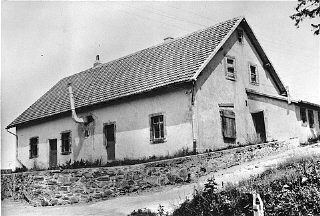
Gas Chamber at Natzweiler-Struthof
The
Natzweiler-Struthof concentration camp was located on top of
a 2,500 foot-high mountain in the Vosges range, which was a ski
area before the camp was built, and still is today. Natzweiler-Struthof
was not a death camp, specifically built for the mass extermination
of the Jews; it was a camp for the imprisonment of convicted
German criminals and Anti-Fascist resistance fighters. However,
one of the reasons that it is so well known in America today
is because a small number of Jews were killed there in a gas
chamber, according to the Simon Wiesenthal Center and the United
States Holocaust Memorial Museum.
The gas chamber building, shown in the
photo above, has been preserved, but it was not open during the
time that I visited. However, it is not necessary to examine
the gas chamber because we have the confession of Josef Kramer,
in which he said that he personally gassed 80 Jews. Kramer made
his confession after he was arrested at Bergen-Belsen when that
camp was voluntarily turned over to the British on April 15,
1945.
Le Struthof, as the camp is known to
the French, was located 31 miles from Strasbourg where Dr. August
Hirt, a Professor at the University of Strasbourg, was conducting
research on racial characteristics. When he requested Jewish
skeletons that were undamaged by bullet holes or body blows,
Heinrich Himmler ordered that Jews should be brought from Auschwitz
to Natzweiler so that they could be killed in a gas chamber there.
In August 1943, a special gas chamber
was constructed by adapting an existing building, formerly owned
by the Struthof hotel, which was located about a mile from the
concentration camp on a side road. This room had previously been
used as a refrigerator room by the hotel.
Killing the Jews in one of the gas chambers
at Auschwitz and shipping the skeletons to Strasbourg wouldn't
do - the skeletons had to be prepared with great care by Dr.
Hirt himself.
According to a Tübingen Professor,
Dr. Hans-Joachim Lang, two anthropologists, who were both members
of the SS, Dr. Hans Fleischhacker and Bruno Beger, were sent
in June 1943 to Auschwitz to select Jews to be gassed so that
their skeletons could be added to the rassistische/rassenideologische
collection of Dr. August Hirt. There were 57 men and 29 women
in the group that was selected.
In the documents submitted to the Nuremberg
International Military Tribunal, it is mentioned that the Jewish
victims were put into quarantine for a time at Auschwitz because
there was a typhus epidemic in the camp; then they were brought
to Natzweiler-Struthof. The Nuremberg IMT documents show that
86 corpses were brought to the Anatomie Institute of the Reichsuniversitat
Strassburg and that an assistant of Prof. August Hirt saw the
tattoos on the arms and secretly wrote down the 86 numbers on
a piece of paper.
 Dr. August Hirt in
his SS uniform
Dr. August Hirt in
his SS uniform
In a Military Tribunal conducted by the
British after the war, Magnus Wochner, an SS staff member who
was among the accused, testified as follows, according to a book
entitled "The Natzweiler Trial," written by Anthony
M. Webb:
I recall particularly one mass execution
when about 90 prisoners (60 men and 30 women), all Jews, were
killed by gassing. This took place, as far as I can remember,
in spring 1944. In this case the corpses were sent to Professor
Hirt of the department of Anatomy in Strasbourg.
Contrary to the statement above, the
gassing actually took place in August 1943, according to the
confession of Natzweiler Commandant Josef Kramer, who was not
among the accused at the trial where Wochner testified.
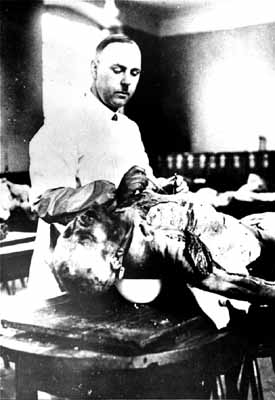 Dr. August Hirt doing
an autopsy
Photo Credit: USHMM
Dr. August Hirt doing
an autopsy
Photo Credit: USHMM
According to Dr. Lang, the files of the
Natzweiler-Struthof camp show that there were 4 Jewish inmates
in the camp on August 1, 1943 and one week later there were 90
Jews, indicating that a group of 86 Jews had arrived. The 29
women were gassed soon after arrival and the following week,
there were 60 Jews in the camp. A week later, after the men had
been gassed, there were only 3 Jews left in the camp since one
of the male Jewish inmates had died during the week that the
women were gassed.
When the Bergen-Belsen camp was turned
over to the British on April 15, 1945, Commandant Josef Kramer
volunteered to stay behind to help the British soldiers take
over the camp, which was experiencing a horrendous typhus epidemic.
Obviously, Kramer had no remorse for his crimes and did not expect
to be arrested, or he would have escaped along with the other
guards who left the camp before the British arrived. Instead,
he met the British troops at the gate and offered his help in
overcoming the typhus epidemic.
The photo below shows Josef Kramer, the
Commandant of Bergen-Belsen and the former Commandant of Natzweiler,
after he was arrested by the British on the first day after they
took over the camp.
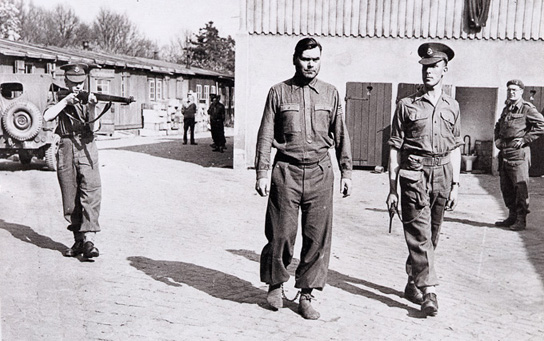 Josef Kramer, former
Commandant of Natzweiler, under arrest at Bergen-Belsen
Josef Kramer, former
Commandant of Natzweiler, under arrest at Bergen-Belsen
In the museum at Natzweiler-Struthof,
Kramer's confession is on display; he described how he personally
mixed "salts" with water to produce a lethal gas. The
gas was dumped through a hole which had been chiseled through
the tiled wall of a room previously used for the refrigeration
of perishable food. Then Kramer watched through a peephole as
the Jews died from the fumes of the poison gas.
Josef Kramer was convicted by a British
Military Tribunal held in 1945, and hanged for the crimes he
had committed at Auschwitz II and Bergen-Belsen. The charges
against Kramer at the proceedings of the British Military Tribunal
did not include the crime of gassing Jews at Natzweiler-Struthof.
Rather, he was charged with crimes committed at Bergen-Belsen
and with gassing Jews at Auschwitz, where he was the Commandant
of the Auschwitz II camp before being transferred to Bergen-Belsen
in December 1944.
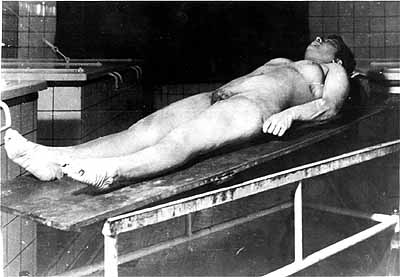 The corpse of a woman
who was allegedly gassed at Natzweiler
Photo Credit: USHMM
The corpse of a woman
who was allegedly gassed at Natzweiler
Photo Credit: USHMM
At the Nuremberg International Military
Tribunal, charges were brought by the American prosecutor against
the Nazis for medical experiments performed at Natzweiler, but
there were no documents introduced in which it was claimed that
a gas chamber had been used there to murder Jews.
The abandoned Natzweiler camp was discovered
by both French and American troops, so it was the responsibility
of the French and the American prosecutors to introduce the evidence
of the gas chamber there.
On December 9, 1944, Colonel Paul Kirk
and Lt. Colonel Edward J. Gully of the US 6th Army made an inspection
of the Natzweiler camp, three months after it had been abandoned
by the Nazis. According to Robert H. Abzug, the author of "Inside
the Vicious Heart," they qualified just about every observation
that had to do with instruments of death and torture. The following
is a quote from Abzug's book:
They found, among other things, "what
appeared to be a disinfestation unit" and "a large
pile of hair appearing and reputed to be human female."
They were shown a building with a space "allegedly used
as a lethal gas chamber. " In this building was "a
cellar room with a special type elevator," and "an
incinerator room with equipment obviously intended for the burning
of human bodies...a cell room and an autopsy room." Kirk
and Gully then described in detail the "so-called lethal
gas chamber," noting every pipe and outlet and its two steel
doors. In the cellar they found four coffins and a sheet metal
elevator "of a size which would take a human body"
with "stains which appeared to be caused by blood."
Kirk and Gully wrote a report that was
sent to the War Crimes Division, in which they referred to a
"so-called gas chamber" at Natzweiler. Based on their
report, there were no charges, pertaining to a gas chamber at
Natzweiler, brought against the Nazis on trial before the International
Military Tribunal at Nuremberg.
The building described in the quote from
Abzug's book is shown in the photo below. This building is the
crematorium which has an elevator, an incinerator room, a cell
room and an autopsy room.
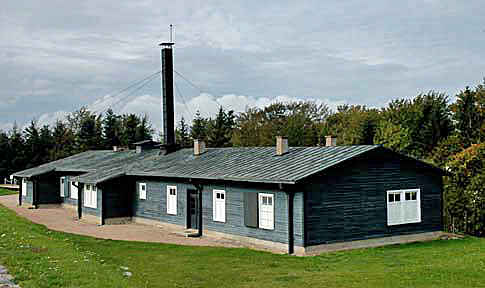 Crematorium building
at Natzweiler-Struthof
Crematorium building
at Natzweiler-Struthof
The photo below shows water pipes going
into what appears to be a shower room which is right next to
the crematory oven. You can see a bit of the crematory oven in
the lower right hand corner of the photo. It appears that the
water for the room might have been heated by the oven, as shown
in the second photo below.
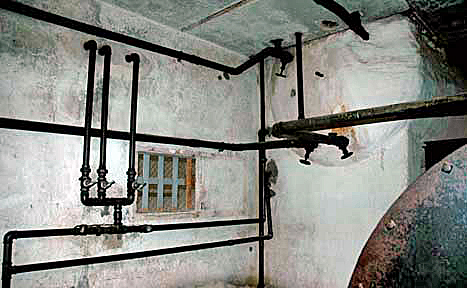 Water pipes going into
shower room next to the ovens
Water pipes going into
shower room next to the ovens
When I visited the Natzweiler camp in
October 2004, the room next to the oven was not open to visitors.
I peeked through the window shown in the photo above and saw
what looked like a shower room. This is probably the "so-called
lethal gas chamber" which the two American officers described
in their report, but there was no sign which said that this was
a gas chamber. This is not the room that Josef Kramer described
in his confession.
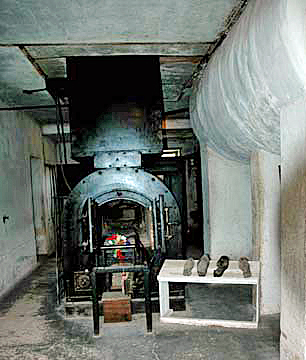 Oven for cremating
bodies at Natzweiler-Struthof
Oven for cremating
bodies at Natzweiler-Struthof
The photo above shows the crematory oven
described by the American Army officers who investigated the
Natzweiler camp in an attempt to find evidence of war crimes.
The shower room is behind the oven and to the right. To the right
in the photograph is a display of the shoes worn by the prisoners
in the camp. The Natzweiler camp had only one crematory oven
since it was not intended to be a factory for mass murder.
Apparently Kirk and Gully were not told
by their French guides that the actual gas chamber was located
on a side road, about one mile distant from the camp. Since they
never saw the real gas chamber, they didn't include it in their
report, and consequently no charges were brought at the Nuremberg
IMT with regard to the gassing of Jews at Natzweiler-Struthof.
In 1989, a plaque was placed at Struthof,
in memory of the "87 Jews who were gassed" there. This
was accomplished through the joint efforts of the Simon Wiesenthal
Center and a New Jersey lawyer, Stephen Draisin. The number 87
includes the 86 Jews who were brought from Auschwitz to be gassed
and one Jewish inmate who died during the same time period.
According to the United States Holocaust
Memorial Museum, "the gas chamber was also used in pseudoscientific
medical experiments involving poison gas. The victims of these
experiments were primarily Roma (Gypsies) who had been transferred
from Auschwitz. Prisoners were also subjected to experiments
involving treatment for typhus and yellow fever."
A book which I purchased from the Memorial
Site has this to say about the gas chamber:
4. The affair of the Israelite corpses
Hirt, professor of anatomy in Strasbourg,
received corpses from the camp of Russian war prisoners at Mutzig,
but as he thought they were too lean, he asked for people in
a good physical condition for studies on heredity.
87 Israelites (30 of whom were women)
were sent from the camp at Auschwitz. They were shut up in block
13 at the Struthof where they were measured, and they had to
undergo experiments on sterilization. On August 11, 13, 17, 19,
1943, under the direction of doctors from Strasburg, the S.S.
gassed the 87 Israelites in the gas chamber at Struthof with
cyanide. Death occurred after 30 to 60 seconds. The corpses were
transported to the Institut d'Anatomie in Strasburg. 17 entire
corpses (3 of which being women's) were found at the liberation
as well as many dissected pieces.
According to Dr. Lang, there were 16
of the 86 bodies (3 women and 13 men) that were found intact
in November 1944, not 17, and an autopsy was performed on the
bodies.
"The liberation" referred to
in the above quote probably means the liberation of France in
August 1944. The Natzweiler-Struthof camp was abandoned in September
1944 so it was not actually "liberated."
Dr. Hans-Joachim Lang was able to identify
the 86 Jews who were gassed at Natzweiler after locating their
prisoner numbers in the Auschwitz archives. The 29 women and
57 men who were gassed had been deported to Auschwitz from Norway,
Poland, Greece, France, Germany, Belgium and the Netherlands.
The bodies of the 86 victims are buried
in the Jewish cemetery of Strasbourg and a grave stone with the
86 names was placed there in December 2005.
Dr. Lang has published a book with the
names of the 86 Jews who were gassed at Natzweiler. His book
can be purchased at this web site:
http://www.die-namen-der-nummern.de
This page was last updated on December
5, 2008
|